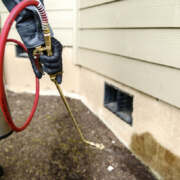Your house is supposed to be air-tight. The interior is supposed to seal off the outdoor temperatures so that your rooms are comfortable all year long.
But you may have noticed that your house doesn’t have a strong building envelope and that the outdoor temperatures are often making their way indoors. In the summer months, the hot, humid air pushes its way inside and forces you to crank up the air conditioning. In the winter months, the frigid cold creeps in and makes you run the furnace at full blast, driving up your energy bills.
You can make your house a lot more comfortable and make your energy bills a lot lower by sealing up air leaks.
Finding Air Leaks
The first thing that you’ll want to do is look at where the air leaks are located in your house. A simple way to find out where these leaks are is to get an energy home evaluation — sometimes called an “energy audit.” A professional will inspect your house and report on areas where energy is being wasted.
If you’d rather do the inspection yourself, you can take a lit stick of incense. On a windy day, hold the lit stick of incense in front of your windows, entrance doors and even your attic. If the smoke from the incense curls upward, then these areas are air-tight—there is no leak to worry about. If the smoke moves toward or away from the surface, then you can assume there is an air leak and that you need to fix it.
How?
Air Leaks Around Windows
You can seal gaps around windows with a fresh layer of caulking. Before you caulk your windows, make sure that you scrape off any old caulking and wipe down the frame. Don’t just add a layer on top. Once the caulking is dried, you can add weatherstripping to the interior of the window sash.
If the windows are old, you shouldn’t look to caulking and weatherstripping as your first solution. You should try to purchase replacement windows made with energy-efficient features from a local window company. Look for energy-efficient features like foam-filled frames, fusion-welded corners and low-emissivity glass. These will provide superior insulation.
Air Leaks Around Doors
If your entrance doors are letting in the outdoor temperatures, add a layer of weatherstripping along the interior of their frames. Get draft blockers for the bottom of the door — this is much easier than propping a door snake in front of your entrance every day.
Air Leaks from Outlets
Your electrical outlets can let in a breeze. You can fix that by insulating your outlets with intumescent fire-blocking aerosol foam. Fire-blocking foam is essential since your outlets could lead to an electrical fire.
Air Leaks from Recessed Lights
Your recessed lights might be bringing in the outdoor air. You shouldn’t stop the air leak with caulking—this can create a fire hazard. Instead, you should add an air-tight baffle behind each light. That should block the air from getting into the room.
Air Leaks from the Attic
Attics are common sources of air leaks because they’re often used as dusty storage spaces, not usable rooms. That means they’re poorly insulated — if they’re insulated at all.
There is a simple fix for this: add more insulation to your attic walls. The right types of insulation should create a strong barrier between the roof and the interior, which will help regulate the temperature in the rest of the house.
Stop letting those air leaks bother you! Read these simple tips and get them fixed!










Comments